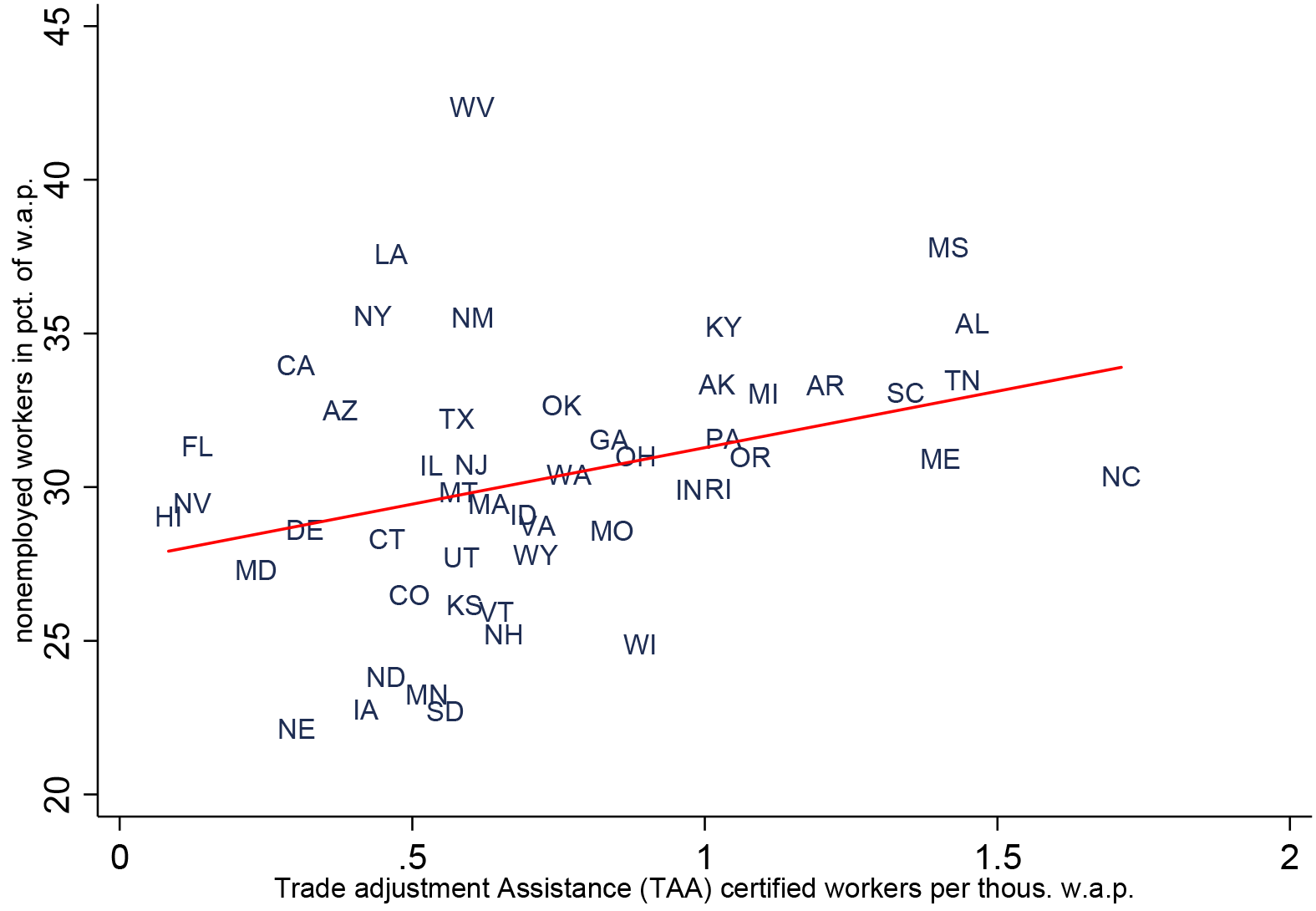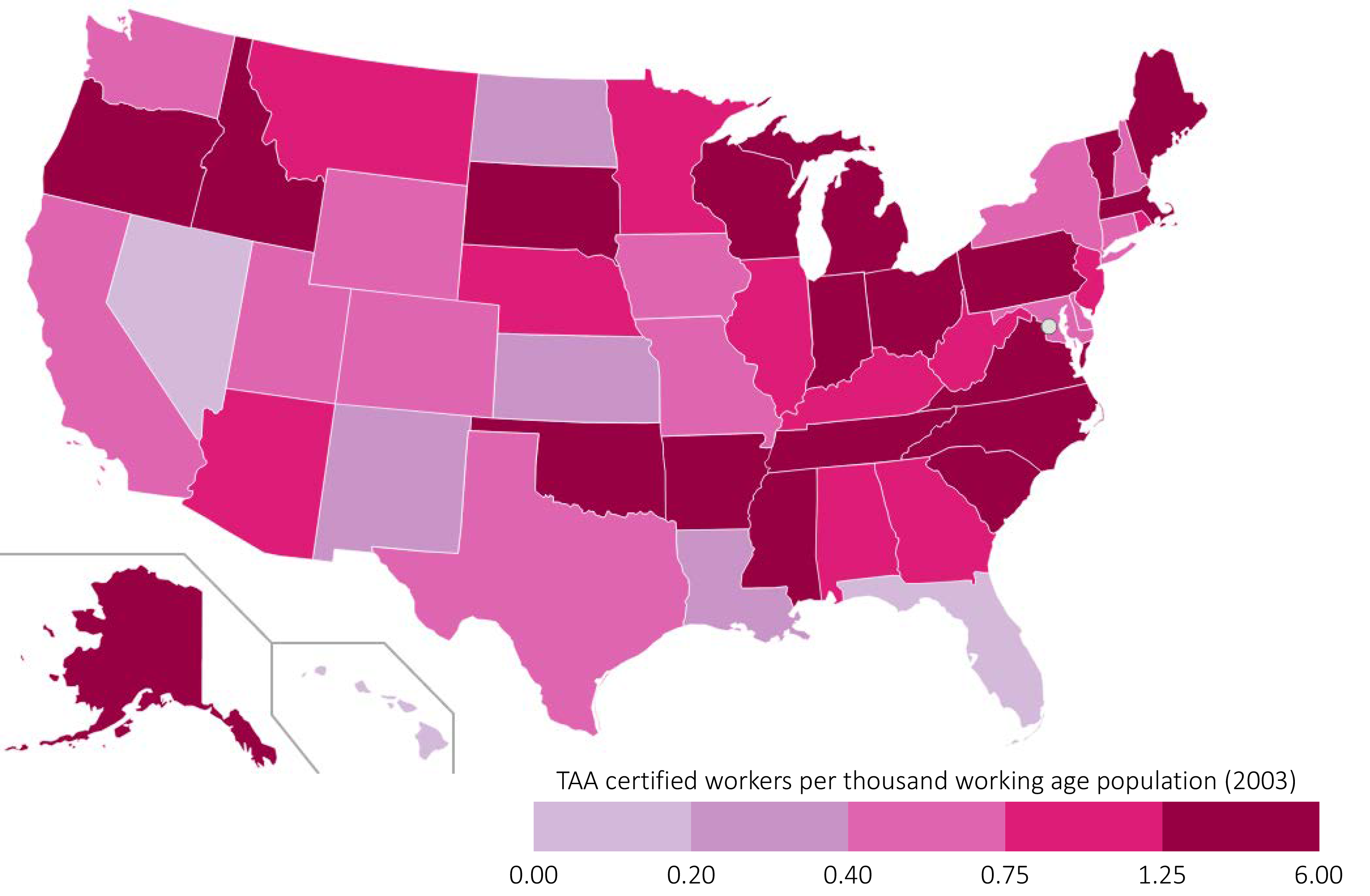IFDP Notes
March 31, 2016
Foreign Competition and Domestic Jobs: Evidence from the U.S. Trade Adjustment Assistance
Illenin O. Kondo1, Federal Reserve Board
Summary
Using data on the certified petitions for U.S. Trade Adjustment Assistance, I document that international trade unevenly affects reallocation and employment across U.S. states. Job gains are precisely lower in the places that shed more jobs due to trade. One extra trade-displaced worker is associated with the net employment falling by two extra workers relative to other locations. These unequal outcomes are in part due to the lack of worker mobility across locations.
With each new round of trade negotiations, policymakers, and economists grapple with the labor market effects of trade reforms. Economists rightly advance the consensus view that freer trade provides overall economic gains. However it is also widely acknowledged that gains from trade are likely to be unequally distributed, with certain workers and industries benefitting while others lose as a result of trade liberalization. Understanding these unequal effects are particularly relevant at the geographic level due to limited worker mobility across locations.
I use data from the U.S. Department of Labor on the certified petitions for Trade Adjustment Assistance (TAA) programs for workers to quantify the impact of trade liberalization on state-level labor markets. Instated as part of the Trade Act of 1974, the TAA for workers is a federal program that aims to support the professional transition of workers displaced due to foreign trade. A critical piece of U.S. trade policy, the program has been reauthorized through 2021 as part of the "Trade Preferences Extension Act of 2015" signed by President Obama in June 2015.
Using this data, I find that international trade affects reallocation and employment unevenly across locations. Job gains are precisely lower in the places that shed more jobs due to trade. Overall, one extra trade-displaced worker is associated with the employment falling by two extra workers relative to other locations. These unequal outcomes are in part a result of the lack of worker mobility towards locations that are gaining from trade.
The TAA certifications data
I construct a state-level annual panel dataset using administrative data on all the certified petitions from 1989 to 2009 under the U.S. Department of Labor's TAA programs for workers. Firms, unions, state unemployment agencies, or groups of three or more workers can file a petition on behalf of a subset of workers at a given establishment.
To determine the eligibility of the petitioning workers, federal investigators with subpoena power must find evidence that these workers were separated because of (a) import competition that led to decline in sales or production, (b) a shift in production to another country with which the United States has a trade agreement, or (c) the loss of business at an upstream supplier or downstream producer for another producer that is TAA-certified.2 Certified workers at a given establishment are eligible to receive benefits such as training, income support, relocation allowances, and healthcare assistance for up to two years.3
For every year $$t$$ and every U.S. state $$i$$, trade-induced foreign competition is measured as the ratio of the workers newly certified for TAA during that calendar year over the working age population (w.a.p.):4
$$$$\;\text{TAA foreign competition}\;_{i ,t} \equiv \frac{\;\text{newly TAA certified workers}\;_{i ,t}}{\;\text{working age population}\;_{i ,t}}$$$$
The maps in Figure 1 and Figure 2 show that TAA-based measure varies across space and over time while being broadly consistent with the conventional wisdom about which places are the most affected by trade competition.
It is useful to contrast the TAA-based measure with the standard import penetration measure of trade competition across locations. For instance, Autor et al. (2013) used the following measure in their influential work estimating the effects of increased Chinese imports on labor markets in the U.S.:
$$$$\text{ADH import penetration}\;_{i ,t} \equiv \sum _{\;\text{industries}\;k}\frac{\;\text{employment}\;_{i ,k ,t}}{\;\text{employment}\;_{i ,t}} \times \frac{\;\text{imports}\;_{U S ,k ,t}}{\;\text{employment}\;_{U S ,k ,t}}\text{.}$$$$
The measure is the average of industry-specific imports weighted by the location-specific industry shares. Clearly, the standard import penetration proxy would assign the same value to two locations with the same industry mix. In contrast, the more direct TAA-based measure may not.
Trade-Induced Foreign Competition and Employment
It is useful to first ask how the TAA-based foreign competition measure broadly co-moves with employment. Figure 3 plots for each state the average over the sample period of the TAA foreign competition measure against the average non-employment rate measured as the sum of the unemployment rate and the non labor force participation rate.
| Figure 3: Nonemployment and TAA certifications in the U.S. (1989-2009) |
|---|
 |
Sources: March CPS and US DoL TAA programs. w.a.p. = working age population. |
Figure 3 shows that locations facing more foreign competition also experience reduced employment. Next, I control for several factors to carefully estimate the correlation between the foreign competition and the non-employment rate as well as other labor market outcomes. However, this correlation does not imply causation: the non-employment rate could affect the number of TAA petitions filed.
Estimation Results
The baseline sample is a balanced panel of 50 states spanning 21 years from 1989 and 2009. To assess the relation between trade-induced foreign competition and labor market outcomes across the U.S., the regression below is estimated:
$$$$\Delta\;\text{labor market outcome}\;_{i ,t} =\alpha \; +\;\beta \times \Delta\;\text{TAA foreign competition}\;_{i ,t} +\;\gamma \cdot \Delta Z_{i,t}+\;\varepsilon _{i,t}{.}$$$$
The variable "TAA foreign competition$$_{i,t}$$" is the share of working age workers TAA-certified in state $$i$$ during the calendar year $$t$$. The variable "$$\Delta\;\text{X}\;_{i ,t}$$" denotes the change from year $$t-1$$ to year $$t$$ in "X$$_{i,t}$$".
The variables used as "labor market outcome$$_{i,t}$$" are: (a) "not employed$$_{i,t}$$", the share of working age population workers who are not employed in state $$i$$ as of the March in the following calendar year $$t+1$$. (b) "job destruction rate$$_{i,t}$$", the rate at which existing jobs were destroyed in state $$i$$ during calendar year $$t$$; (c) "job creation rate$$_{i,t}$$", the rate at which new jobs were created in state $$i$$ during calendar year $$t$$; (d) "pop.share$$_{i,t}$$", the share of national working age population residing in state $$i$$ as of the March CPS in calendar year $$t+1$$. The controls $$Z_{i,t}$$ include state indicators, year indicators, the state log income per working age population, the state share of U.S. working age population, and the state unionization rate.
The estimation results are reported in Table 1. One extra trade-displaced worker is associated with the overall employment falling by nearly two extra workers relative to other locations. The more trade-induced displacements, the less reallocation there is. The reduced reallocation partly comes from the fact that locations with more trade-induced displacements trivially shed more of their existing jobs. Moreover, these locations also create fewer new jobs. As shown by the population regression in the specification (d3) of Table 1, people tend to move very slowly in response to these shocks.5
These findings are robust to various controls especially industrial composition. These findings do not hold when the standard import penetration proxy is used instead of the direct TAA measure, as shown in the specification (a2) of Table 1. These effects are robust to spillovers in the non-tradable sector as measured by new housing starts. Further controls include the state unionization rate and the state TAA denied workers.
| Table 1: Labor Market Outcomes Estimation across the United States |
|---|
Labor Market Outcomes | Δ | Δ Not Employed a2 | Δ Not Employed a3 | Δ | Δ | Δ |
|---|---|---|---|---|---|---|
Foreign Competition Variables: | 2.011*** | - | 2.380*** | 1.574*** | -1.332*** | 0.0048 |
Foreign Competition Variables: | - | .00070 | 0.0011 | - | - | - |
Additional Controls: | 0.383 | - | 0.302 | -0.032 | -0.378 | -0.030** |
Additional Controls: | -2.191*** | -3.880*** | -2.429*** | -1.649*** | 2.975*** | -0.023 |
Additional Controls: | -0.251*** | -0.287*** | -0.249*** | -0.023 | 0.020 | -0.00096* |
Additional Controls: | - | - | -0.307*** | - | - | - |
State FE, Year FE | Yes, Yes | Yes, Yes | Yes, Yes | Yes, Yes | Yes, Yes | Yes, Yes |
R-sq. | 0.3266 | 0.2506 | 0.3037 | 0.6886 | 0.4404 | 0.1762 |
N | 1050 | 800 | 750 | 1050 | 1050 | 1050 |
Note: *, **, and *** denote significance at the 10, 5, and 1 percent level. Robust standard errors in parentheses are clustered on states. The estimation sample is a balanced panel of the 50 states that spans 21 years from 1989 and 2009. Union data is only available after 1989 in the March CPS. Import penetration can only be constructed between 1988 and 2005 with a gap in 1998 to a change from SIC to NAICS.
Obviously, these findings do not mean that there are no gains from trade. Instead, they highlight the differential response across locations, after controlling for import penetration and the industry-mix. Kondo (2013) considers these heterogeneous labor market outcomes using a model of international trade. Monarch et al. (2014) also features an insightful study of offshoring on employment at the firm-level.
References
Autor, David H., David Dorn, and Gordon Hanson, "The China Syndrome: Local Labor Market Effects of Import Competition in the United States," American Economic Review, October 2013, 103 (6), 2121-68.
Kondo, Illenin, "Trade Reforms, Foreign Competition, and Labor Market Adjustments in the US," FRB International Finance Discussion Paper, 2013, (1095).
Monarch, Ryan, Jooyoun Park, and Jagadeesh Sivadasan, "Gains from Offshoring? Evidence from US Microdata." FRB International Finance Discussion Paper, 2014, (1124).
Rosen, Howard F., "Trade Adjustment Assistance: The More We Change the More It Stays the Same," in C. Fred Bergsten and the World Economy, Peterson Institute for International Economics, 2006, pp. 79-113.
1. The views expressed herein are those of the author and do not necessarily reflect those of the Board of Governors of the Federal Reserve System or its staff. Return to text
2. For each petition, federal investigators issue a "confidential data request" (CDR) for data such as sales history, sales of import-competing products, major declining customers and unsuccessful bids. Return to text
3. Naturally, one would be concerned about how political pressures affect the odds of being certified. Before 1980, unionized auto workers would get certified during seasonal slowdowns. This led the Reagan administration to revamp the program and the certification process (see Rosen, 2006 for a detailed history). The sample only starts in 1989. Return to text
4. The state is used as a geographic unit in order to have annual time series and to exploit a vast array of economic co-variates regularly available at the state-level but not at finer levels. Return to text
5. As found in the literature, the relationship with wages (not reported here) is not significant. Return to text
Please cite as:
Kondo, Illenin O. (2016). "Foreign Competition and Domestic Jobs: Evidence from the U.S. Trade Adjustment Assistance," IFDP Notes. Washington: Board of Governors of the Federal Reserve System, March 31, 2016. https://doi.org/10.17016/2573-2129.18
Disclaimer: IFDP Notes are articles in which Board economists offer their own views and present analysis on a range of topics in economics and finance. These articles are shorter and less technically oriented than IFDP Working Papers.


